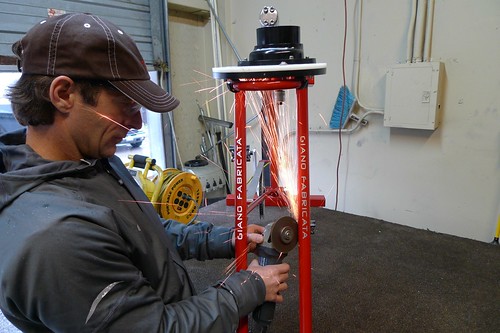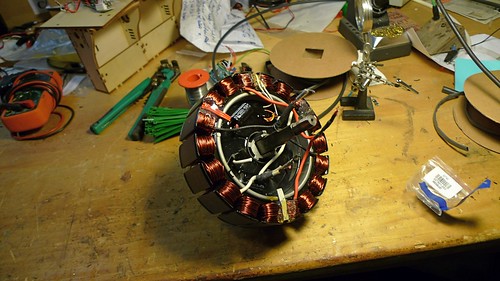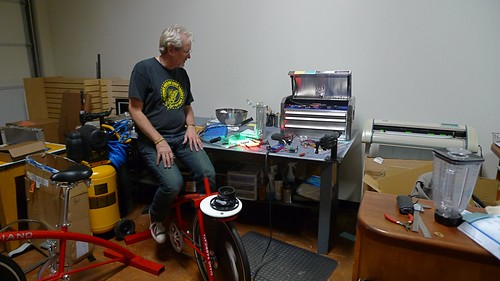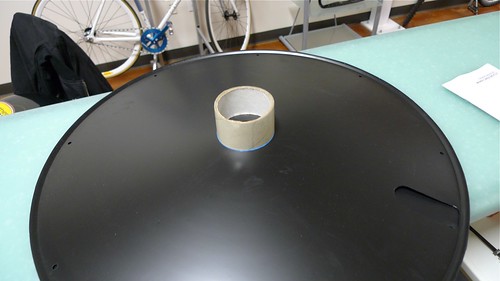Update from Austin’s first Pedal Powered spin class
Rock The Bike is helping Pure Austin Fitness pedal power their spin class. Pure already owns two of our Fender Blender Pros, and the goal of the current project is to convert these bike blenders to pedal power generators using our latest technology, then use them to pedal power the audio in their spin class. Here are some shots from the work I did in Austin over the past five days.

On Friday I met up with Pure Austin’s Beto Boggiano at his workshop. We chopped off the dropouts on the Fender Blender Pro frames, in order to respace them for the new generator hubs.

We used the generator hub itself to position the dropouts at the correct width, rather than, say, measuring the distance with a caliper and then holding the dropouts with a pair of vice grips. The gym mats and wood are to lift the hub and hold it at the correct position for tacking.

Here’s a shot of the inside of our generator hub. The copper coils move past rare earth magnets that are bonded to the inside of the aluminum hub shell, creating an electric charge that makes current flow through a cross-bridge rectifier. From the Wikipedia page on generators:
A generator forces electric charges to move through an external electrical circuit, but it does not create electricity or charge, which is already present in the wire of its windings. It is somewhat analogous to a water pump, which creates a flow of water but does not create the water inside. The source of mechanical energy may be a reciprocating or turbine steam engine, water falling through a turbine or waterwheel, an internal combustion engine, a wind turbine, a handcrank, compressed air or any other source of mechanical energy.

Above: Beto tacking the dropouts back on in their new position.

After welding the dropouts back to the frame at the correct width, it was time to rebuild wheels around the new hubs. The rim and tire add mass that creates a flywheel, smoothing out the pedal power. Plus, with a tire back on, the tire-rubbing bike blender interface will still completely functional (though optional). Pure Austin will be able to rotate the blender’s roller away from the tire during the spin class (to minimize noise and power loss), and then move it back to crank out smoothies for the cyclists after the class.
Before the trip, Rock The Bike’s engineer Leif had encouraged me to build the wheels ahead of time so that I could devote my time to installing the system once in Austin. Unfortunately I ran out of time preparing for Austin and instead brought rims and spokes with me. I ran into a number of issues. In the photo above, note the spoke nipples poking way out of the rim. I’d built up the wheel as a one cross when the spokes were spec’ed for a two-cross pattern.

Fortunately, these missteps and delays gave me a chance to bike around Austin on a bright blue Mundo and meet several cool salesmen and mechanics at Bicycle Sport Shop, Austin Bikes, and Mellow Jonny’s. I was impressed how much people in Austin already knew about the Mundo and its development, considering there are only a few Mundo riders there. I got stopped in front of bars for test rides and one rider even flagged me down… “Is that a Mundo?” It’s amazing how well educated and networked bike people can be about the products they buy.
 The Monday 6PM spin class came and went without Pedal Power. I did get to see Beto, the gym’s owner and most experienced spin coach in action, which was great. The big black box on the floor between the palm tree and the instructor’s podium is a digitally powered JBL PRX subwoofer. The main speakers are mounted to the ceiling. You can see one of them at the top of this image just right of center. The mains are powered by two rack-mounted amplifiers, out of view. Hopefully we’ll be able to Pedal Power both the amps and sub. But we won’t know until we try.
The Monday 6PM spin class came and went without Pedal Power. I did get to see Beto, the gym’s owner and most experienced spin coach in action, which was great. The big black box on the floor between the palm tree and the instructor’s podium is a digitally powered JBL PRX subwoofer. The main speakers are mounted to the ceiling. You can see one of them at the top of this image just right of center. The mains are powered by two rack-mounted amplifiers, out of view. Hopefully we’ll be able to Pedal Power both the amps and sub. But we won’t know until we try.

Above: Bob Farr, an old-school Austin Xtracycle rider, and pedicabber, showed up Monday for the Pedal Power Workshop at Pure Austin. The technical delays described above limited our ability to fill the sweaty gym air with solder fumes at the workshop, but I was able to show Bob lots of good data and parts on paper and on Pure’s public iMac. The next day Bob showed up to help me bust out the last few details of installing the generator wheels. Here Bob is pedal powering 80 watts of LED lighting, a successful test of the Electric FB Pro.

Above: tracing a round object to mark a cut in the wheel covers, making room for the larger hub.
We succeeded in electrifying both of Pure’s Fender Blender Pros. The next step on the project is to build them a Pedal Power Utility Box. I would have liked to have the triumph of a pedal powered spin class, but at least we finished the primary goal of converting the two FB Pros they had, and I won’t have to fly back to Austin to complete the project.
Pure will have time to thoroughly test the system before using it at their fitness expo, March 6.


